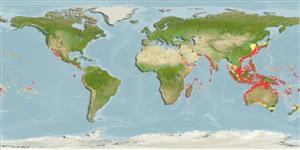Classificação / Names
Common names from other countries
Referência principal
Tamanho / Peso / Idade
Max length : 102 cm FL macho/indeterminado; (Ref. 9684); common length : 55.0 cm TL macho/indeterminado; (Ref. 55763); Peso máx. publicado: 10.7 kg (Ref. 168)
Ambiente
; marinhas; oceanódromo (Ref. 51243); intervalo de profundidade 1 - 167 m (Ref. 58302)
Clima / Intervalo
Subtropical; 14°C - 23°C (Ref. 168), preferred 28°C (Ref. 107945); 43°N - 41°S, 24°E - 77°W (Ref. 168)
Distribuição
Indo-Pacific: widespread but with many gaps in its known distribution. Eastern Pacific: Hawaiian Islands and Pacific coast of USA to southern tip of Baja California and Tres Marias Islands extending to Cabo Blanco, Peru (especially during El Niño events), the Galapagos Islands and Gulf of Guayaquil.
Países | Áreas FAO | Ecossistemas | Ocorrências | Introduções
Descrição breve
Espinhos dorsais (total): 17 - 19; Espinhos anais 0; Raios anais moles: 14 - 16; Vértebras: 44 - 45. Mouth moderately large. Laminae of olfactory rosette 21 to 39. Interpelvic process small and bifid. Body completely covered with very small scales posterior to the corselet. Swim bladder absent. Spleen large and prominent in ventral view. Liver with elongate left and right lobes and a short middle lobe. Back with narrow oblique stripes.
Categoria na Lista Vermelha da IUCN (Ref. 115185)
Ameaça para o homem
Harmless
Utilização humana
Pescarias: pouco comercial; peixe desportivo: sim
Mais informação
ColaboradoresFotografiasStamps, CoinsSonsCiguateraVelocidadeTipo de nataçãoÁrea branquialOutras referênciasCérebrosVisão
Ferramentas
Relatórios especiais
Descarregue XML
Fontes da internet
Estimates of some properties based on models
Phylogenetic diversity index
PD50 = 0.5312 many relatives (e.g. carps) 0.5 - 2.0 few relatives (e.g. lungfishes)
Nível Trófico
4.2 ±0.69 se; Based on food items.
Resiliência
Médio, tempo mínimo de duplicação da população 1,4 - 4,4 anos (Assuming tm=3-4)
Vulnerabilidade
Moderate to high vulnerability (51 of 100)
Categoria de preço
